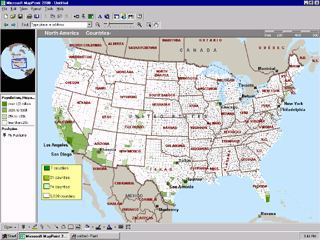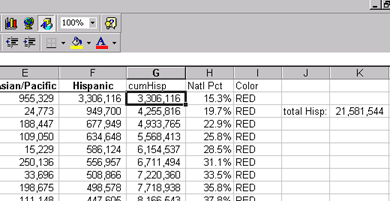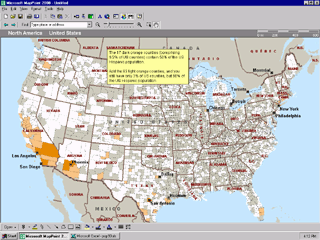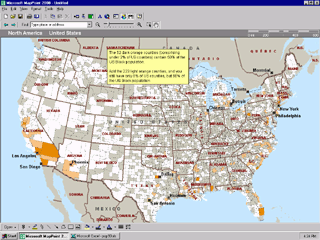 |

|
|
|
The 80/20 RuleIn the real world, getting all the sales or all the market is usually not feasible. MapPoint can help you get 80% with 20% of the effort.
April 5, 1999 - We often say that Microsoft was trying for the 80/20 rule in mapping software when it developed the feature specifications for MapPoint 2000. Many features of higher-end (more expensive, more powerful, and more difficult) mapping packages were deliberately left out or designed around, in order to deliver a package that would be simple enough for "regular people" to use, but still powerful enough to meet the large majority of their mapping needs. The same kind of lesson can be fruitfully applied in marketing, sales, and promotion planning; and MapPoint 2000 can be a big help. It is almost never a good idea to develop a plan to get all of your audience, even if you have unlimited resources. Find out where your target is concentrated and deploy promotional dollars there. For illustration purposes, we'll take a look at the distribution of the Hispanic and Black population across the United States. This may not be a target market for you, but there will probably be some set of demographic characteristics that define the audience you're after, and the lessons here should apply to you. Using the data supplied with MapPoint 2000, here is the distribution of Hispanics across the contiguous 48 states, mapped by county:
 We've customized the breaks a bit to emphasize the concentration of this population. Note that only 112 counties out of 3,141 (about 3%) have at least 25,000 Hispanic citizens. Now we need to do a little work in Excel to prepare for our "80/20" analysis. In MapPoint, with the above map in view, we used the box ("drag a box to zoom in") tool to draw a rectangle around the contiguous 48 states. Then we right-click inside the selection and choose "Export to Excel." This opens Excel and fills it with our demographic data by county. We want to determine those counties we'd need (taking the fewest) to get to first 50% of the US Hispanic population, and then 80%. Here are the steps we need to take in Excel:
 Now we're ready to map the data. In MapPoint, we do a thematic map, using the "color" column above. Here's the resulting map:
 The Hispanic population is extraordinarily concentrated, as should be our marketing efforts. Here's an 80/20 map for the Black population in the United States:
 This same principle can be applied on a regional or local basis. In that case, you'd probably use zip codes or census tracts as the unit in your map. In our experience, it is surprising how many products and brands turn out to be regional; and surprising how often managers may not be aware of that. Even if the product sells well across the country, regional variations in packaging and content can give a boost.
 Author: Scott Elliott Author: Scott ElliottEmail: scott.elliott(AT)directionsmag.com URL: http://www.directionsmag.com Scott Elliott enjoys Amis, Ellison, Ford, Hardy, Percy, Tolstoy, Turgenev and some living writers. He is Publisher of Directions and MP2K magazines.
|
|
||||||||||||||||||||||||||||||||||||||||||||||||||||||||||||||||||
|
||||||||||||||||||||||||||||||||||||||||||||||||||||||||||||||||||||






